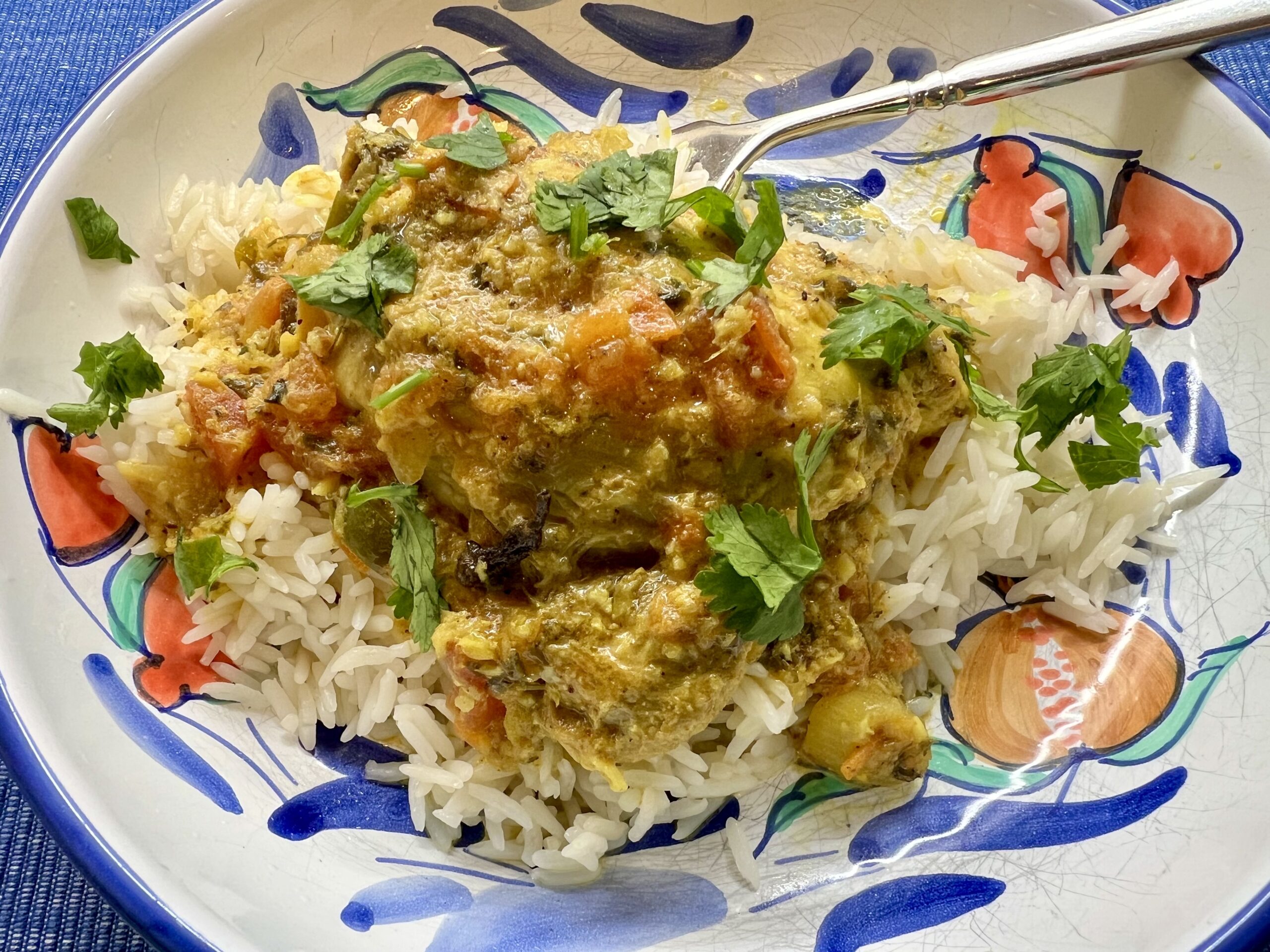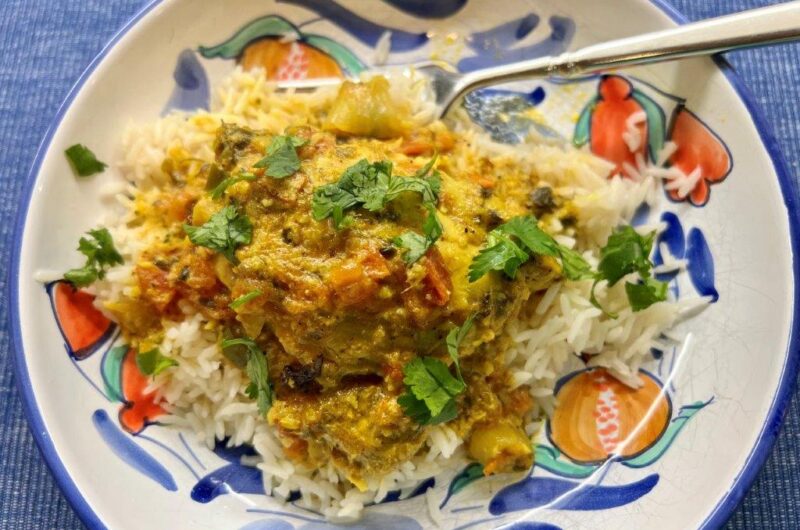This recipe requires a disclosure, and here it is: if you don’t really like to cook that much, don’t make this dish. Unlike most of the recipes featured in this blog, North Indian Chicken Curry is a heavy lift.
But man, is it worth it. Witness the fact that I serve it in shallow bowls with forks and spoons—the former for consuming the chicken, and the latter for slurping up all that spectacular sauce.
I learned to love Indian food in college, during a semester abroad in Cambridge, England. My first week, another ex-pat took me to eat biryani and samosas—gateway foods for the pedestrian palate. “Why Indian?” I remember asking. “It’s edible and affordable, plus it’s delicious,” she replied, placing Indian food in direct contrast with about 90% of the other restaurant meals I encountered in the UK. Remember, it was the late 80s, before England’s culinary revolution, and one bad Wimpy burger could give you Mad Cow.
Back to the recipe at hand: there is no technique employed here that qualifies this as “advanced.” Rather, it’s that this recipe requires starting early in the day (or the night before) and lots of hands-on chopping and cooking time. Compounding matters, there are no fewer than 23 (!!) ingredients, and a handful of them require a visit to a specialty store—probably an Indian market.
For years, I avoided real Indian cooking for this very reason. I didn’t want to drive across town to the Indian market, and invest in bags of spices that I knew I wouldn’t use frequently (looking at you, black cardamom pods).
But Indian food is my absolute favorite ethnic food – my husband’s, too. Give us an Indian restaurant over Chinese, Sushi or French any day of the week. (By the way, I realize saying “Indian food” is a bit like saying “European food”–there are vast differences between regional cuisines…hence the “North” modifier in this recipe’s title. Most people in the South are strict vegetarians.)
So a few years back, I requested an Indian cookbook for Christmas, and received two – Anupy Singla’s Indian for Everyone and Priya Krishna’s Indian-ish – and I was off and running.
These days, I love an excuse to visit the Indian market. It’s like a field trip to an exotic land without jetlag and the expensive plane ticket. At Patel Bros., I’m usually the only white face in there. I wouldn’t blame the proprietors for rolling their eyes and muttering, “Oh look, another white girl got Indian-ish for Christmas.” To the contrary, I’ve found the market staff to be very friendly and helpful in locating various ingredients.
Kasoori Methi, Paneer and Hing, oh my! Dorothy, we’re not in Publix anymore.
The good news is that the spices are inexpensive (many are just $3-4 for about 2 cups’ worth—McCormick is ground gold compared to SWAD brand), and they keep for years, if stored in airtight containers. I loved stumbling across this video of Kamala Harris (whose mother is Indian) and Mindy Kaling, discussing how all good Indian aunties store their spices in Taster’s Choice jars. In the Strawberry Kitchen, Ball jars work just as well.
If you’re where I was a few years ago, and love authentic Indian food but only when someone else is making it, maybe 2023 will be the year you take the plunge into cooking this incredible cuisine yourself. I guarantee your dinner guests will applaud your culinary courage, and you’ll savor the journey.
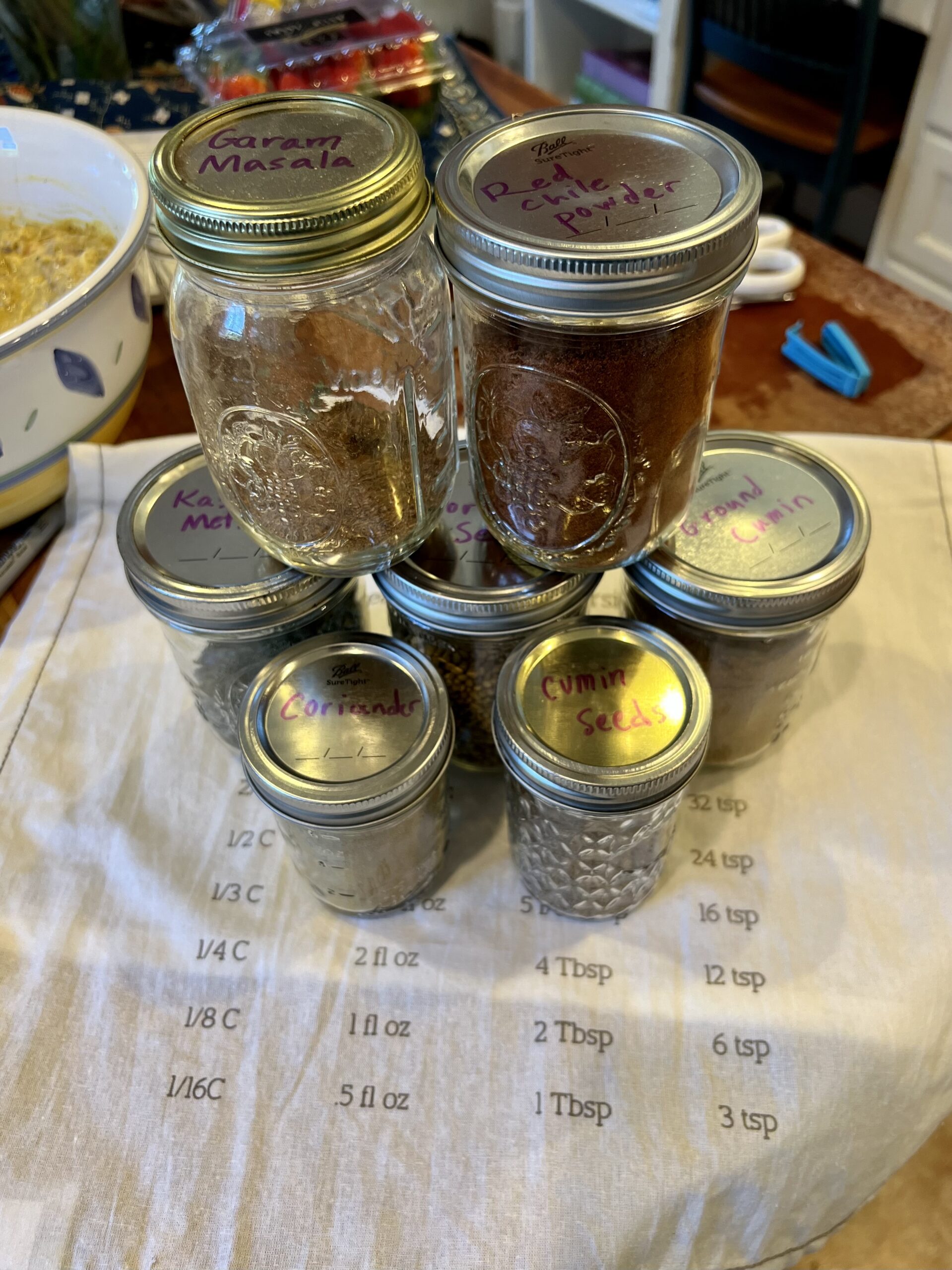
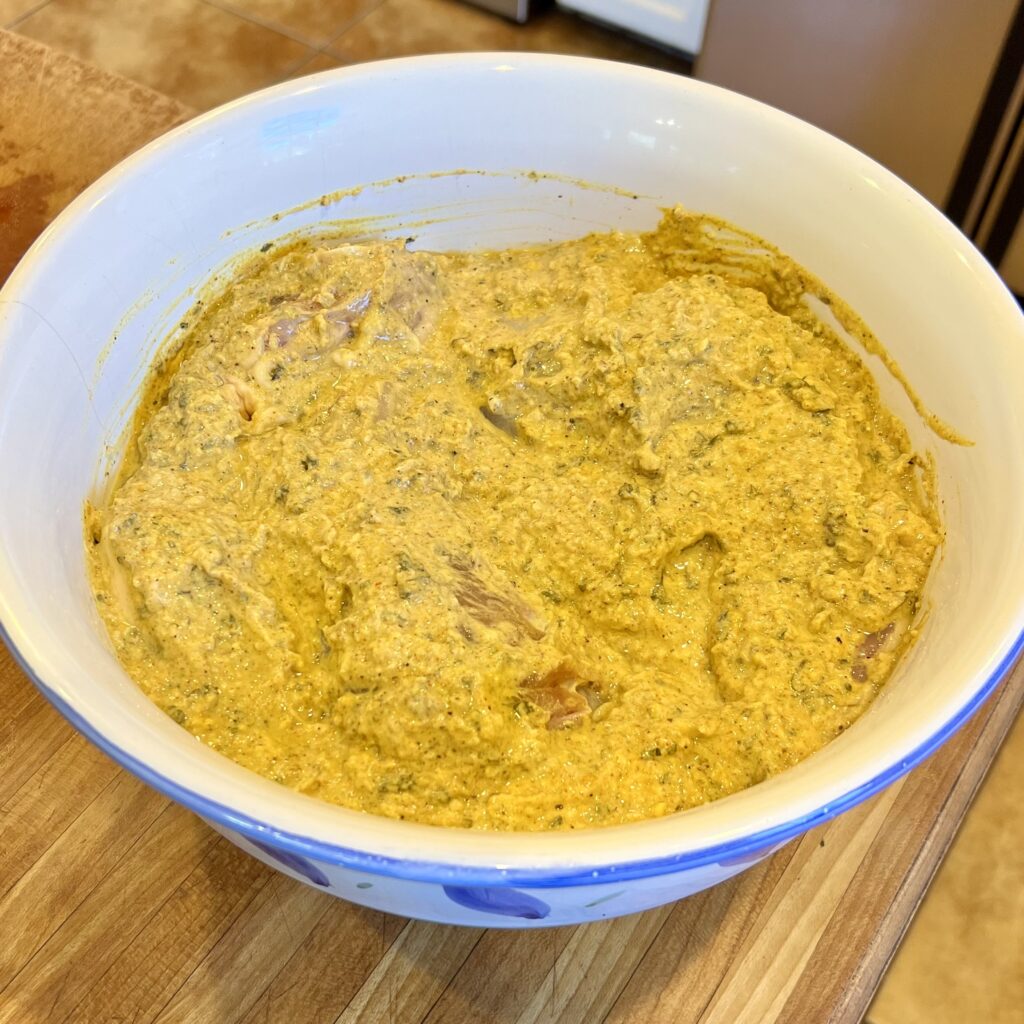
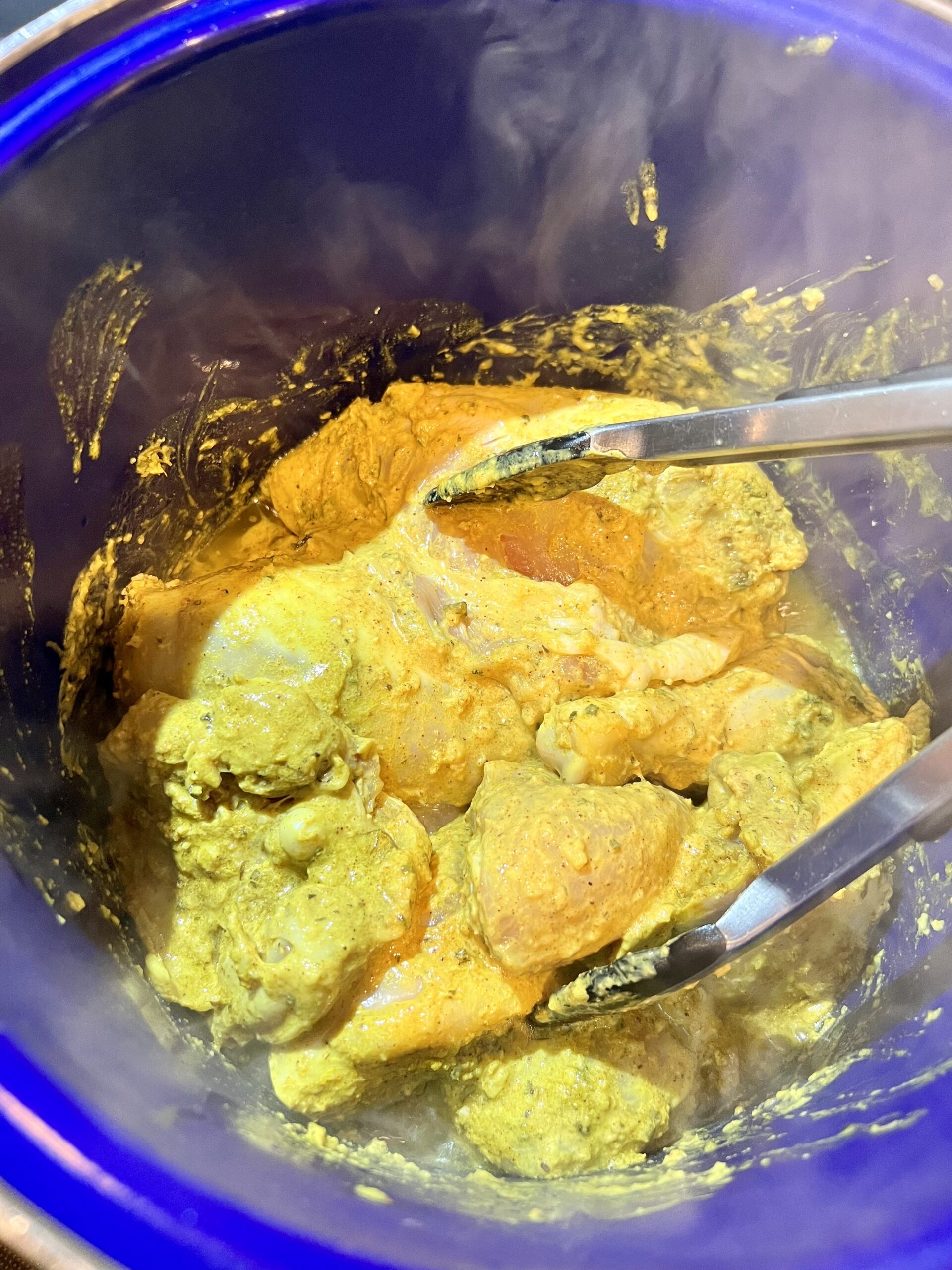
One final disclosure about this recipe: it is not my own. I took it from Singla’s book (with minor adjustments), and haven’t found it anywhere else online. Ms. Singla, if you happen to stumble across this blog post, I hope you’ll consider it flattering that I’m sharing it.
North Indian Chicken Curry
Course: MainDifficulty: Labor-intensive but worth it!6
servings1
hour2
hoursBegin this recipe in the morning, or the night before. It’s a time investment that yields spectacular flavor dividends. We like spicy food; if you don’t, reduce or eliminate the red chile powder.
Ingredients
2 onions: one medium, roughly chopped, and one large, thinly sliced
1 4-inch piece ginger, peeled and roughly chopped
10 cloves garlic, peeled
2 1/2 cups plain yogurt
1 1/2 tsp. salt
1 Tbs. turmeric powder
1 Tbs. garam masala (see note)
1 tsp. red chile powder or cayenne pepper
2 tsp. ground coriander
2 tsp. ground cumin
1/3 cup Kasoori Methi (dried fenugreek leaves), lightly hand crushed to release flavor* (see note)
4-5 pounds bone-in, skinless chicken pieces (combination of breasts, thighs, and drumsticks works well)
6 Tbs. ghee, divided
1 tsp. cumin seeds*
2 sticks cinnamon
5 whole cloves
5 green cardamom pods, lightly crushed*
2 black cardamom pods*
3 large tomatoes, diced
1 Thai or serrano chile pepper, stem removed and chopped
1/3 cup chopped fresh cilantro, for garnish
Basmati rice or naan for serving
Directions
- Either the night before or the morning you plan to serve, in the bowl of a food processor, grind 1 medium chopped onion, the ginger, and the garlic into a smooth paste.
- Transfer to a large mixing owl and add the yogurt, salt, turmeric, garam masala, red chile powder (if using), coriander, cumin and kasoori methi. Whisk until well blended.
- Prepare chicken by poking holes in it with a fork to help it absorb the yogurt marinade. Carefully add the pieces of the chicken to the marinade and gently stir until all the pieces are evenly coated. Cover and refrigerate at least 2 hours, or overnight.
- In a large, (at least 6 quart) saute pan or dutch oven over medium-high heat, warm 3 Tbs. ghee. Using tongs, carefully transfer the pieces of chicken to the saute pan, reserving the marinade for later use. (I usually try to squeegee some of the marinade off of each piece with my hand or a spatula before adding chicken to pot). Cook, turning once to ensure even cooking, for a total of 4 minutes (chicken will still be largely raw). Transfer chicken to a large plate or bowl, and transfer the remaining liquid in the pan to the reserved marinade to add later.
- Return the pan to medium-high heat and warm the remaining 3 Tbs. ghee. Add the cumin seeds, cinnamon, cloves, and green and black cardamom and cook for 2 minutes. Add the sliced large onion and a pinch of salt, and cook, stirring constantly and scraping the pan to prevent burning, for 3 minutes, until the onion is slightly browned. If the spices are sticking to the bottom of the pan, it’s ok to add a tablespoon or two of water to loosen them and prevent burning.
- Add the tomatoes to the pan and cook, uncovered and stirring occasionally (breaking down the tomatoes with the back of the spoon), for about 8 minutes, until they are fairly smooth. Add the reserved marinade and cooking liquid from step 4 and the fresh chiles to the pan and cook two minutes.
- Reduce the heat to low and carefully return the chicken to the pan. Partially cover the pan and cook, stirring occasionally to ensure even cooking, about 45-50 minutes (less if you’re using boneless chicken), until the chicken is cooked through. Remove from the heat.
- Transfer to a serving bowl. Garnish with cilantro, and serve with basmati rice or naan.
Notes
- Ground garam masala can be purchased in conventional grocery stores. However, it’s so much better if you buy a bag of the whole spices, dry roast them well in a pan over medium heat for about 5 minutes, allow them to cool, and then grind using a powerful blender or spice grinder. This will store well in a jar for, in my experience, years, and can be used in many Indian recipes. The bags of whole spices will look something like this at the Indian grocery.
- You should not substitute fresh fenugreek leaves or fenugreek seeks for Kasoori methi. It will alter the flavor. To my palate (and sniffer), kasoori methi is what elevates many home-cooked Indian dishes to “restaurant quality.” It is very inexpensive and found in boxes at the Indian market.
- *the ingredients marked with an asterisk are ones you’re unlikely to find in a conventional grocery store, even Whole Foods.

